
Abhandlungen Der Akadamie der Wissenschaften in Göttingen. Philologisch- Historische Klasse. Dritte Folge Nr. 28 ..
Some observations on al-Ism al-a`zam : An Isma'ili text ed. Strothmann- Gnosis-Texte der Ismailiten.
Stephen Lambden UC Merced.
1980s + Under revision 2018-9.
IN PROGRESS - last updated 11-02-2023
ln 1943 Strothmann published in the Abhandlungen Der Akadamie der Wissenschaften in Gottingen Phililogisch-Historische Klasse (Series 3, No. 28) 1943 some interesting 'Gnosis-Texte Der lsmailiten' (lsmā'īlī Gnostic Texts) contained in original mss. located in the famous (around c. 1605 founded) and rich in oriental texts Ambrosian Library in Milan (ltaly)1 (Arabische Handschriften Ambrosiania H. 75 ). The lsmā'īlī texts are introduced on pp.1-62 of the Strothmann section with the 'Four Arabic lsmā'ili' texts, printed on pp. 1-180. The fourth of them is the Risālat al-lsm al-a'zam (Treatise on the Mightiest Name [of God]) occupying just 5 pages (pp. 171-176) appended on pp. 178-180 by a al-Kitābat al-sirriyya ("Note on the Mysterious Sigla") or a key to an Arabic secret alphabet utilized in the latter work.
The Risālat al-lsm al-a`zam opens with the standard basmala Bismillah al0Rahman al-rahim, "In the Name of God, the Merciful, the Compassionate" and blessings upon the Prophet Muhammad and lmam 'Alī then the other lsmā'īlī lmams and finally upon Our Master and Our Sayyid, the [lsmā'īlī] "lmam of Our Age", al-Tayyib Abī al-Qāsim (d. c. 500?/1106-7??), the son of al-Āmir bi-Hakīm Allāh (d. 524/1130) the 20th Musta'lī lmam. Though he was murdered or deceased as an infant al-Tayyib (after whom the Tayyibiyya branch of the lsmā'illis is named + rerlated to the lndian Bohras) 2 was later recognized as the lmam by some Musta'lī groups in Egypt, Syria and Yemen.3
FNs.
1 "It was founded by Cardinal Federigo Borromeo and became one of the earliest libraries to be opened to the public
2 El2 al-Tayyibiyya , a branch of the lsmā'īliyya [q.v.] with several subdivisions. The Tayyibiyya split off from the rest of the Musta'lī lsmā'īlīs soon after the death in in 524/1130 of the Fātimid caliph al-Āmir bi- Hakīm Allāh, recognised as the twentieth imām of the Musta'lī lsmā'īlīs. The official Musta'lī da'wa organization in in Cairo recognised al-Āmir's cousin and successor on the Fāļimid throne, al-Hāfiz (d. 525/1131), and the later Fātimids as the rightful imāms. However, some Musta'lī groups in Egypt and Syria as well as the majority in Yeman acknowledged the rights of al-Āmir's infant son al-Tayyib to the imāmate, rejecting the claims of al-Hāfiz and the Musta' lī da 'wa. These Musta' lī lsmā'īlīs were initially known as al-Āmiriyya, but later, after the establishment of the independent Tayyibī da'wa in Yeman, became designated as al-Tayyibiyya."
3 On early Tayyibi-Musta'li History in Egypt and Yemen see 2003 = The Fatimids and their Successors in Yaman, an Arabic edition and English summary of volume 7 of ldris 'lmad al-Din's 'Uyun al-akhbar edited by Ayman Fu'ad Sayyid, (Fourth in the lnstitute's lsmaili Text and Translation Series).
________
This possibly 12th cent CE lsmā'īlī treatise on the Mightiest Name may be the earliest commentary on the graphical Shīī form of the Mightiest Name. Each of the 7 sigla are given a detailed exposition in the light of lsmā'īli gnosis, mysticism and numerology. 12 elements are found to constitute the 7 sigla which are exegetically-eisegetically related to the 12 letters composing the shahada-lā ilāha ila Allāh ...
The inverted letter wāw is, among other things equated with the First lntellect...
ln this Isma'ili treatise, Risālah on the Mightiest Name, he is depicted as Amīr al-Mu'minīn (Commander of the Faithful), and the Locus of Divine Bounty and Nobility ...
ADD HERE
The al-ism al-a'zam is depicted as a seven-fold series of sigla (sing. sigil > Latin Siglum = lit. "seal"): 4
- [1] a khātim "seal" though set down here as a circular Arabic letter "h" =
- [2]
- [3]
- [4]
- [5]
- [6]
- [7] the inverted wāw though a little different from that in SKR graphic
- diagram:
4. "A symbol designed for a specific magical purpose is called a sigil. The plural is sigla. Occultists may prefer to employ the anglicized plural "sigils". The term sigil derives from the Latin sigilum meaning "seal." The old norse binding rune is an example of the idea. However, sigla differ from runes as they are designed not to represent an alphabet but are created to form a glyph, composed of a variety of symbols or concepts with the intent and inherent iconic meaning ..... A sigil may have an abstract, pictorial or semi-abstract form. It may appear in any medium, physical or virtual, or only in the mind. Visual symbols are the most popular form, but the use of audial and tactile symbols in magic is not unknown. " WEB ??
______
It is said to have been described by al-Hakīm (the Wise One = lmām 'Alī ? cf. the lsmā'īlī lmām) through his saying -- there follows an n early recension of the Poem of 'Alī is previously cited:
- "It is [2] three rods after [1] a seal (khātim) after the likeness of a straightened lance;
- [3] A [letter] mīm etc
- [4] Sullam ilā al-ma'mūl but nota sullam
- [5]
- [6]
- [7] And a hā' and a wāw upturned
This is not the only lsmā'īlī commentary on the graphical form of the ism Allāh al-a`zam, See Delia Cortesse, Arabic lsmaili Manuscripts, The Zāhid 'Alī [1888-1958] Collection ( London: Tauris, 2003) - donated to the lnstitute of lsmā'īlī Studies London in 1997. p. 183 = Ta'wīl ism Allāh al-a'?am, dated 8th Rabī al-ākir 1270/ 5th Jan. 1854. = A short treatise on the esoteric interpretation of the 'most excellent name of Allah, here given in cryptography". 2 small chapters 1st on shahāda. 2nd on the ranks of the da'wa ansd their alphabetical equivalents. See Gaeck llS 1: no. 156; Poonawala p. 340 (No. 179).
♦
Gnosis-Texte der Ismailiten:
arabische Handschrift Ambrosiana H 75, Volume 3, Issue 28 within
Abhandlungen der Akademie der Wissenschaften in Göttingen, Philologisch-Historische Klasse Biblioteca ambrosiana, R. Strothmann. Göttingen: Vandenhoeck & Ruprecht, 1943. 275 pages. The Arabic section within this volume is headed Arbaʿa kutub ismāʿīlīya. It is 261 pages long with a 61 page German section.
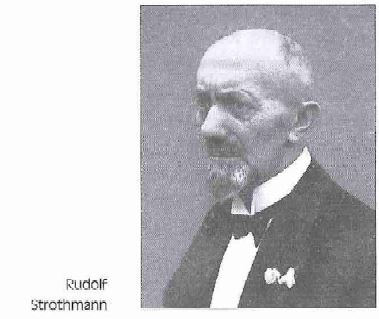
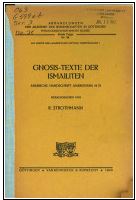
Rudolf Strothmann (1877-1960).
- Gnosis-Texte der Ismailiten : Arabische Handschrift Ambrosiana H 75 = Arbaʿa kutub ismāʿīlīya / hrsg. von R. Strothmann. — Göttingen : Vandenhoeck & Ruprecht, 1943. — 62, 215 pages (Akademie der Wissenschaften zu Göttingen Philologisch-Historische Klasse Abhandlungen der Akademie der Wissenschaften zu Göttingen, Philologisch-Historische Klasse ; Abhandlungen der Akademie der Wissenschaften zu Göttingen, Philologisch-Historische Klasse).
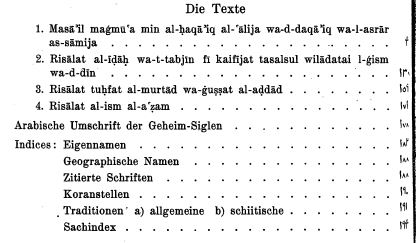
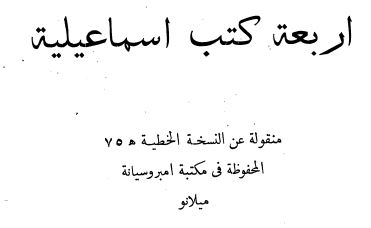
As indicated above, the four Isma'ili works - Arba'at Kutub Ismā'īlīyah / Arba'at kutub ismā'īlīyah - published here are :
- (1) Masā'il majmū'ah min al-ḣak̇ā'ik̇ al-'āliyah, by an unknown author;
- (2) al-Īḍāḣ wa'l-tabyīn, by 'Alī b. Muḣammad b. al-Walīd;
- (3) Tuḣfat al-murtād, by the same;
- (4) Risala al-ism al-a'ẓam, by an unknown author.
- PDf.
An Ismā’īli commentary on the Graphic form of the Mightiest Name of God
Perhaps dating 700 years before Sayyid Kazim Rashti wrote his commentary is the Ismā’īli commentary on the Mightiest Name of God. In 1943 Strothmann published in the Abhandlungen Der Akadamie der Wissenschaften in Gottingen Phililogisch-Historische Klasse (Series 3, No. 28) 1943 some interesting `Gnosis-Texte Der Ismailiten’ (Ismā’īlī Gnostic Texts) contained in original mss. located in the famous (around c. 1605 founded) and rich in oriental texts Ambrosian Library in Milan (Italy) (Arabische Handschriften Ambrosiania H. 75 ). The Ismā’īlī texts are introduced on pp.1-62 of the Strothmann section with the `Four Arabic Ismā’īlī’ texts, printed on pp. 1-180. The fourth of them is the Risālat al-Ism al-a`ẓam (Treatise on the Mightiest Name [of God]) occupying just 5 pages (pp. 171-176) appended on pp. 178-180 by a al-Kitābat al-sirriyya (“Note on the Mysterious Sigla”) or a key to an Arabic secret alphabet utilized in the latter work.
The Risālat al-Ism al-a`ẓam opens with the standard basmala … and blessings upon the Prophet Muhammad and Imam `Alī then the other Ismā’īlī Imams and finally upon Our Master and Our Sayyid, the [Ismā’īlī ] “Imam of Our Age”, al-Ṭayyib Abī al-Qāsim (d. c. 500?/1106-7??), the son of al-Āmir bi-Ḥakīm Allāh (d. 524/1130) the 20th Musta’lī Imam. Though he was murdered or deceased as an infant al-Tayyib (after whom the Tayyibiyya branch of the Ismā’īllis is named- they are related to the Indian Bohra Isma'ili faction) was later recognized as the Imam by some Musta`lī groups in Egypt, Syria and Yemen.
This possibly 12th cent CE Ismā’īlī treatise on the Mightiest Name may be the earliest commentary on the graphical Shī`ī form of the Mightiest Name. Each of the 7 sigla are given a detailed exposition in the light of Ismā’īli gnosis, mysticism and numerology. 12 elements are found to constitute the 7 sigla which are exegetically-eisegetically related to the 12 letters composing the shahada—lā ilāha ila Allāh… The inverted letter wāw is, among other things equated with the First Intellect…
It is said to have been described by al-Ḥakīm (the Wise One = Imām `Alī ?cf. the Ismā’īlī Imām) through his saying -- An early recension of the Poem of `Alī is cited:
- “It is [2] three rods after [1] a seal (khātim) after the likeness of a straightened lance;
- [3] A [letter] mīm etc • [4] Sullam ilā al-ma`mūl but not a sullam • [5] • [6] • [7] And a hā’ and a wāw upturned
Centrally important are the Shī`ī representations of the Mightiest Name of God certain of which are based upon directives spelled out in a tradition ascribed to Imam `Alī b. Abī Ṭālib (d.40/661), the son in law of the prophet Muhammad. The graphic form of the al-ism al-a`ẓam is often depicted in poetical form as a seven-fold series of letters, signs, seals or sigla (pl. sing. sigil > Lat. Siglum =lit. “seal” ; the singular sigil indicates a symbol designed for a specific magical purpose is called a sigil).
He [Imam `Alī] said:
- [1-2] Three rods (`uṣiyy) in a row [ ] after a seal [khātam = above them the likeness of a straightened lance [‑‑].
- [3] A blind [Arabic letter] M [mīm ﻡ ] without a tail;
- [4] then a ladder unto all that is hoped for, but which is not a ladder
- [5] Four things like fingers in a row, pointing to good deeds, but without a wrist [ ]
- [6] And a [letter] "H" (hā' ) which is cleft (shaqīq) [ ]
- [7] ثم واو منكوس كانبوب حجام و ليس جم "Then an inverted [letter] wāw و ) like the syphon of a phlebotomist (ka‑anbūb ḥajjām, "tube of the cupper") though not a cupping glass (miḥjam) :
Above is the 7th depiction within Imam `Alī’s poetic and graphic description of the sevenfold sigla or cipher‑letter‑signs constituting one of the graphic representations of the Greatest Name of God. The seven successive `letters' are a sigla of the `Mightiest Name’ of God’ They have been interpreted to look like this in one Qajar period Shaykhi manuscript (which adds a second khatam in the form of a pentalpha or five pointed star:
THE ISMA'ILI TREATISE
In the Risālah on the Mightiest Name he is depicted as Amīr al-Mu`minīn (Commander of the Faithful), and the Locus of Divine Bounty and Nobility…
The opening lines of the Risala on the al-ism al-a`zam as printed in Strothmann 1943:
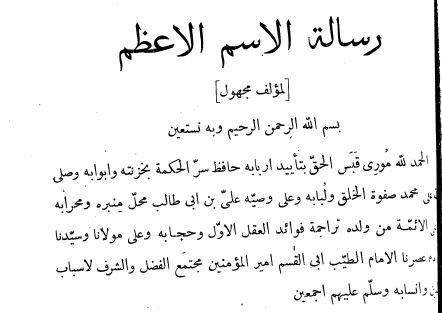
The Treatise on the al-ism al-a`zam (Mightiest Name [ of God] ) [by an unknown author].
Lambden Trans. - to be completed ...
In the Name of God, the Merciful, the Compassionate,
for in Him do we seek help.
Praised be to God, the Enkindler of the Firebrand of the True One [God] / Truth (qabas al-haqq) through the assistance of his Gates (abwab), the Preserver of the mystery of his Wisdom (sirr al-hakmat) in His Treasury ([ma]khazanat) and by means of His Gates (abwab). And blessings be upon Muhammad, the apex of His creatures [creation] (safwat al-khalq) and His quintessence (lubab) and upon His legatee (wasi), Ali Ibn Abi Talib, the very locus of his Pulpit (mahall minbar), His Niche (mihrab) among the Imams of His progeny, the interpretors [communicators] of the benefits of the First Intellect (tarajimat fawa'id al-aql al-awwal) and His Veilong (hijab), And [blessings] be upon our master (mawla) and our Lord (sayyid), the ?? of our era , the Imam al-Tayyib, Abi Qasim (the Father of al-Qasim), the Amir al-Mu'minin (Commander of the Faithful), the Confluence of the Divine Bounty and Nobility (mujtama` a al-fadl wa al-sharaf)
To be added HERE
Appendix on Strothmann and his works...
Biographical notes:
- B. Spuler, "Rudolf Strothmann (1877-1960)", Isi., XXXVI/1 -2 ( 1960), pp. 1-3;
- R. Paret, "Rudolf Strothmann (4 .9.1877-15.5.1960)", ZDMG, CXI (1962), pp. 13-15;
- R. Sellheim, "Autobiographische Aufzeichnungen und Erinnerungen von Cari Brockelmann", Oriens, XXVII ( 1981), p. 42;
- Mecdüddin K!vanı. "İştrutman, Rudolf', DMBİ, IX, 9-10
- See further :
- https://www.deutsche-biographie.de/sfz123929.html#indexcontent
I draw here on `STROTHMANN, Rudolf; by Hilal Görgün in TDV İslâm Ansiklopedisi :
Other works or editions of Strothmann include :
- https://catalog.hathitrust.org/Search/Home?lookfor=%22Strothmann, Rudolf, 1877-%22&type=author&inst=
- https://babel.hathitrust.org/cgi/pt?id=mdp.39015049227856
See Also :
- http://worldcat.org/identities/lccn-nr91019267/
- http://ismaili.net/heritage/doc/author/Strothmann?sort=title&order=asc
- Kultus der Zaiditen. Strassburg, K. J. Trübner, 1912. 76 pages.
- https://catalog.hathitrust.org/Record/001139705?type%5B%5D=author&lookfo...
- PDf. https://babel.hathitrust.org/cgi/pt?id=mdp.39015049227856
-
Die Zwölfer Schīʾa; zwei religionsgeschichtliche Charakterbilder aus der Mongolenzeit. Leipzig, Otto Harrassowitz, 1926 126 pages. Reprint, Hildesheim ; Georg Olms, 1975.
Daylamī, Muḥammad ibn al-Ḥasan, fl. 1308
- Bayān madhhab al-Bāṭinīyah wa-buṭlānih / manqūl min kitāb qawāʻid ʻaqāʾid Āl Muḥamma. Istanbūl : li-Jamʻiyat al-Mustashriqīn al-Almānīyah,1938 or 9.
- https://catalog.hathitrust.org/Search/Home?type%5B%5D=author&lookfor%5B%...
Ziyaeddin İsmail b. Hibetullah el-İsmaili el-Süleymani.
- Kitab al-mizan wa'l-tasnim (Jsmailitischer Kommentar zum Koran, I-lV, Göttingen 1947-1955.
Jaʻfar ibn Manṣūr al-Yaman (10th cent. CE).
- كتاب الكشف Kitab al-Kashf (ed.) Strothmann. Islamic Research Association series, no. 13. London ; New York ; Bombay ; Calcutta ; Madras : G. Cumberlege : Oxford university press, 1952. Isma'ili Qur'an Commentary.



